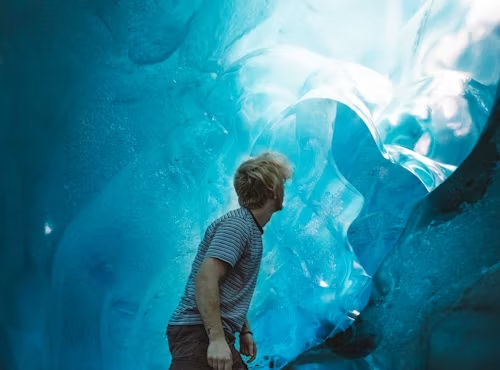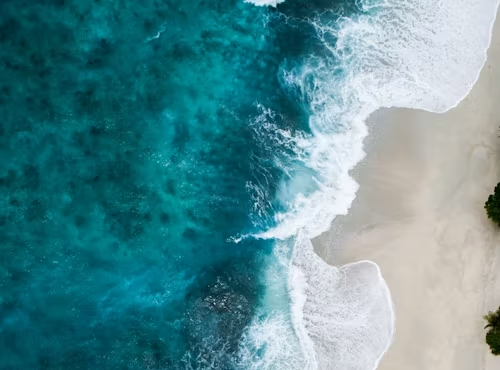After a challenging hike, few rewards compare to encountering a waterfall. Witnessing Mother Nature’s raw power invokes awe and deepens our appreciation for natural beauty. This primal instinct drives us to seek the world’s grandest and most spectacular waterfalls. In this article, we’ve curated a list of some of the world’s top 10 breathtaking waterfalls to inspire your cascade-chasing adventures.
Explore the Top 10 Breathtaking Waterfalls Around the World!
African Waterfalls: Nature’s Spectacular Cascades
Tugela Falls, South Africa
Tugela Falls, situated in South Africa’s KwaZulu-Natal region within Royal Natal National Park, is a seasonal marvel of five distinct free-leaping falls. It is named after the Tugela River, which is derived from the Zulu word for “sudden.” With a combined drop of 948 meters, it ranks among the world’s tallest waterfalls, though measurements are debated. It could potentially rival Venezuela’s Angel Falls for the top spot.
Hiking to Tugela Falls provides varied experiences depending on the season, influenced by the fluctuating flow of the Tugela River, which can even dry up completely. The falls are most impressive during the summer months (November to February), especially after periods of heavy rainfall. Accessible via challenging hiking trails to both the summit and base, the park’s visitor center offers detailed information on routes, with the Bushmen Painting Trail being a popular choice among visitors.
Victoria Falls, Mosi-oa-Tunya
Victoria Falls, known locally as Mosi-oa-Tunya (The Smoke that Thunders), straddles the border between Zambia and Zimbabwe, fueled by the Zambezi River. Spanning 1,708 meters in width and dropping 108 meters, it boasts the world’s largest sheet of falling water. Despite not being the tallest or widest, Victoria Falls impresses with its scale—twice the height of Niagara Falls and more than twice as wide as Horseshoe Falls.
Visitors to Victoria Falls can engage in various adventurous activities, including white water rafting, swimming in Devil’s Pool, bungee jumping, zip-lining, sunset cruises, and scenic hikes. Due to fluctuating water levels, the availability of activities varies seasonally, making planning essential. Accessible from Victoria Falls town in Zimbabwe and Livingstone in Zambia, the falls offer captivating views from both countries, ideal for combining with explorations in nearby South Africa, Namibia, or Botswana.
Antarctica’s Frozen Cascades: Exploring Nature’s Icy Spectacles
Blood Falls, Antarctica
Bloodfalls in Antarctica are a striking natural phenomenon emerging from the Taylor Glacier, spilling crimson-hued water onto the frozen expanse of West Lake Bonney. This eerie spectacle owes its color to iron-rich, extremely salty water from a subglacial reservoir, which oxidizes upon contact with oxygen and light, creating its distinctive red appearance.
To witness Blood Falls, travelers can embark on helicopter tours or Antarctic cruises across the icy Ross Sea. These expeditions offer a rare opportunity to explore this remote geological wonder and its surrounding Antarctic landscape. They glimpse the complex environmental processes in one of Earth’s most secluded regions.
Asia’s Diverse Waterfalls: Exploring Nature’s Cascading Marvels
Detian Falls/Virtuous Heaven Waterfall and Ban Gioc Waterfall
Detian Falls, also known as Virtuous Heaven Waterfall and Ban Gioc Waterfall in Vietnamese, spans the border between China and Vietnam. Its enchanting tiers cascade amidst karst peaks. Celebrated as Asia’s largest transnational waterfall, Detian captivates with its dynamic nature, splitting into two distinct cascades at times and reuniting during the rainy season when the river swells.
Travelers can access Detian Falls from the Chinese side via a bus journey from Nanning, exploring attractions such as serene fishing pools beneath the falls and scenic spots like Heishui River and Qiaomiao Lake. On the Vietnamese side, Ban Gioc Falls in Cao Bang province offers seasonal delights and bamboo rafts for a close-up view of this natural wonder amidst red blossoms in spring, golden foliage in autumn, and the dramatic flow of summer rains.
Hannoki Falls, Japan
Hannoki Falls, situated in Toyama Prefecture, stands as Japan’s tallest waterfall, towering at 497 meters. Its cascades, however, only flow from April to July, sustained by snowmelt from the Midagahara plateau. In the remainder of the year, attention turns to its neighboring cascade, Shomyo Falls, also revered as Japan’s tallest during its seasonal peak. Together, they form a picturesque V-shape, earning them the moniker of the twin waterfalls. This region is renowned as one of Japan’s premier koyo spots, where autumn transforms the landscape into a vibrant display of colorful foliage, akin to the cherry blossom season in spring.
To reach Japan’s tallest waterfalls, Hannoki and Shomyo, the best time to visit is from April to July, when both cascades are at their fullest. Accessible by car, the road to the falls closes in winter due to snow and typically reopens around mid-May. During July and August, the road operates from 6 am to 7 pm, while in other months, it generally opens from 7 am to 6 pm. For those using public transportation, start your journey at Tateyama Station and catch the bus to Shomyo Falls, available from May to November, offering a convenient way to experience these natural wonders without a car.
Jog Falls, India
Jog Falls, situated in Sagara Taluk within Karnataka’s Shivamogga district, India, is renowned for its segmented cascades. The volume of water flowing over the falls fluctuates with rainfall and seasonal changes, transforming it into a formidable plunge waterfall during peak water levels. Fed by the Sharavathi River, Jog Falls plunges from a height of 253 meters, making it India’s second-highest waterfall after Nohkalikai Falls. Locally, the falls are also known by various names, such as Gerusoppe Falls, Gersoppa Falls, and Jogada Gundi.
The ideal time to explore Jog Falls is from August to December. Travelers typically journey from Bangalore to Sagara, where buses can reach the falls, with nearby villages including Siddapura and Sirsi. At Jog Falls, the View Point provides a stunning perspective from the base of the falls, accessed via a challenging hike along 1,400 cliffside steps. Another excellent viewpoint is located near Kodakani village in Siddapura, Uttara Kannada, offering a picturesque panorama of this impressive natural wonder.
Khone Phapheng Falls, Southern Laos
Khone Phapheng Falls, situated in the Champasak Province of southern Laos, is Southeast Asia’s largest waterfall. Fed by the Mekong River, the falls cascade through an archipelago of thousands of small islands, collectively known as Si Phan Don (Four Thousand Islands). Referred to as Chutes de Khone or simply Khone Falls, this natural wonder boasts the world’s widest waterfall title, stretching an astonishing 10,782 meters across—nearly double the width of its closest rival, Pará Falls in Venezuela.
Near Khone Phapheng Falls, south of Don Khon island, resides a small population of rare Irrawaddy dolphins. This area is also inhabited by the playback, an endangered species of catfish considered one of the largest freshwater fish globally, reaching lengths of up to three meters and weighing as much as 300 kilograms.
Nohkalikai Falls, India
Nohkalikai Falls, situated near Cherrapunji in India, is the country’s tallest waterfall, plunging 340 meters. Fed by the abundant rainfall of one of the world’s wettest places, the falls experience reduced flow during the dry season from December to February. Ranked as the fourth tallest waterfall globally, Nohkalikai is renowned for its vividly colored lagoon at the base and the natural splendor of the surrounding evergreen forest.
According to local lore, a woman named Likai lived in a village above the falls and remarried after her husband’s death to support her infant daughter. However, her second husband grew jealous of Likai’s affection for her child and killed the girl, cooking her flesh and discarding the remains. Upon returning home from work to an empty house, Likai unwittingly ate the meal prepared by her husband.
It was only after finishing her meal and reaching for a betel leaf that she discovered a severed finger. Overcome with grief and horror upon realizing the truth, Likai threw herself off the plateau, and the place where she fell became known as Nohkalikai Falls, serving as a grim reminder of the tragic tale.
Thi Lo Su Waterfall, Thailand
Nestled within Thailand’s Umphang Wildlife Sanctuary, a UNESCO World Heritage Site in the north, Thi Lo Su Waterfall unveils itself amidst one of Southeast Asia’s few remaining virgin forests. The falls derive their name from a local dialect, where “Thi Lo” translates to waterfalls and “Su” denotes loud, describing the thunderous roar and powerful rush of water. However, the Karen hill tribe refers to the falls as “Black Waterfall,” adding to the mystery of its origins. Ranking as the sixth largest waterfall globally, Thi Lo Su originates from Huai Klotho, coursing down limestone cliffs in majestic tiers. Visitors can explore a cave behind the falls and swim in the pools formed by cascading currents.
To reach Thi Lo Su Waterfall, embark on a five-hour drive from Tak City to Umphang, followed by a 1.8-kilometer hike along a self-guided forest trail. Camping is available at the Wildlife Sanctuary Headquarters near the falls, ideally between October and December when the waterfall is most picturesque. It’s important to note that visiting during the rainy season (May to August) may lead to temporary closures of the sanctuary due to heavy rainfall.
Europe’s Enchanting Waterfalls: Discovering Nature’s Cascading Treasures
Gullfoss “Golden Falls,” Iceland
Gullfoss, known as the “Golden Falls,” is located in southwest Iceland within the canyon of the Hvítá River. This majestic waterfall descends in a curved three-step “staircase,” plunging the rushing waters into deep perpendicular crevices, with summer flows reaching up to 140 cubic meters per second. One of Gullfoss’s unique features is its ability to be viewed above as the falls cascade into an underground passage. Various angles and viewpoints around the falls offer breathtaking perspectives and opportunities to capture rainbow-sprayed photos. Even in winter, Gullfoss remains accessible, surrounded by a dream-like blanket of snow, though caution is advised due to snowy and icy conditions for driving and walking near the falls.
The Gullfoss Falls are conveniently located just an hour and a half from Reykjavik. They are commonly included in the Golden Circle itinerary, whether you’re on a guided tour or exploring by self-drive. This 300-kilometer tourist route forms a loop from Reykjavik into the southern uplands, highlighting three main attractions: Gullfoss Falls, Thingvellir National Park, and the geothermal area of Haukadalur, renowned for its Geysir and the active Strokkur geyser.
Conclusion:
Exploring 10 of the world’s largest and most stunning waterfalls reveals nature’s awe-inspiring beauty and geological marvels. From the towering heights of Tugela Falls in South Africa to the immense breadth of Victoria Falls straddling Zambia and Zimbabwe, each waterfall tells a tale shaped by time and nature’s forces. Whether witnessing the chilling mystery of Blood Falls in Antarctica or the serene majesty of Thi Lo Su in Thailand’s Umphang Wildlife Sanctuary, these destinations beckon adventurers to marvel at their sheer power and captivating beauty, offering unforgettable experiences amidst the planet’s extraordinary landscapes.





